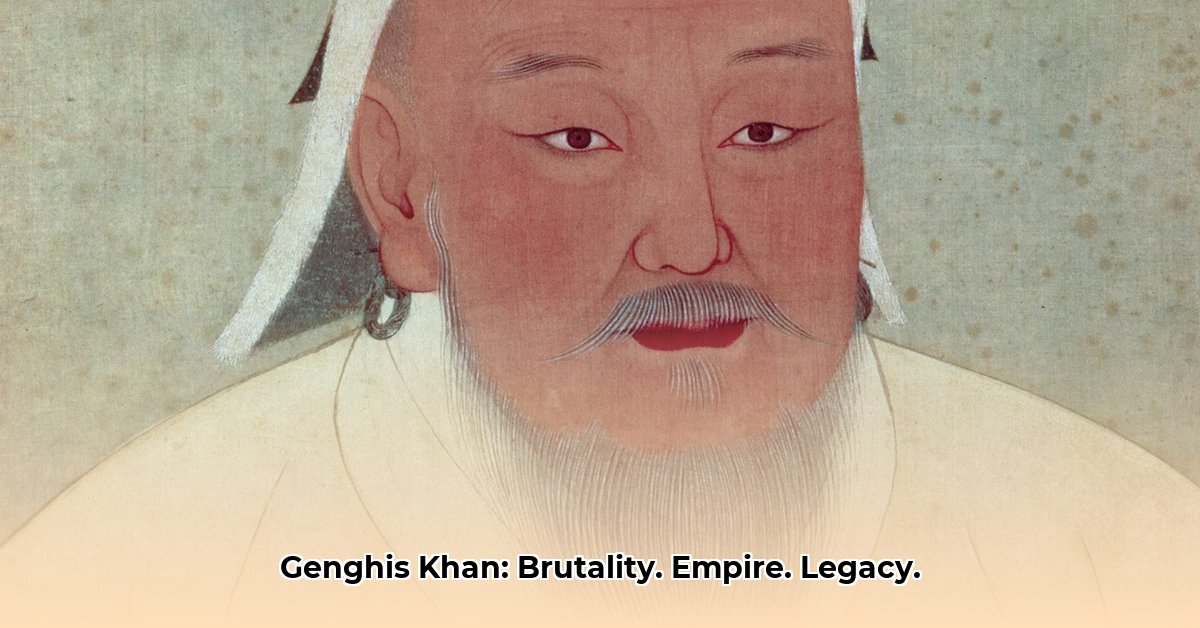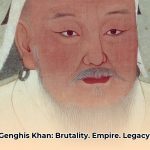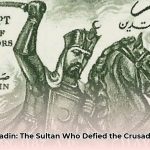Genghis Khan. The name alone conjures images of vast armies, devastating battles, and an empire forged in blood that reshaped the world. But this is a story far more nuanced than mere conquest. This article delves into the intricate tapestry of Genghis Khan’s Mongol Empire, examining the military strategies that fueled its expansion, the unique attributes of its warriors, and the climate of fear that facilitated its dominance. We will chart the course of his conquests, illustrating the organization of his forces and the annexation of extensive territories across Asia. While acknowledging the undeniable brutality of his campaigns, we will also explore the surprising era of peace and prosperity that followed, revealing the complex and often contradictory legacy of this historical figure. This exploration, grounded in thorough research, aims to provide a comprehensive understanding of a man whose impact continues to resonate centuries later. For more on military strategy, see Sun Tzu’s insights.
Genghis Khan: Military Genius and the Mongol Empire’s Ascent
Genghis Khan’s name is synonymous with sweeping cavalry charges, unparalleled military campaigns, and a ruthlessness that instilled terror. However, understanding his legacy requires acknowledging his multifaceted nature: a military strategist of exceptional skill, a leader of cunning and charisma, and a conqueror whose actions indelibly shaped the course of Eurasian history. His story is one of innovation, strategic organization, and the unexpected emergence of relative peace from the crucible of war, elements that contributed to a lasting and complex legacy.
Mongol Cavalry: Masters of Horsemanship and Tactical Innovation
Envision armies possessing the agility and coordination of a finely tuned machine, engaging with a fluidity that belied their martial purpose. This was the hallmark of the Mongol army under Genghis Khan. Their mastery of mounted archery was legendary. Mongol cavalry, moving with incredible speed, could unleash a lethal barrage of arrows from a distance, an advantage unmatched by many of their adversaries. This blend of speed, precision, and range enabled them to outmaneuver and overwhelm their enemies with devastating effect. But was it solely their skill in archery that made them formidable?
The Battle of the Kalka River in 1223 provides a compelling illustration of their tactical ingenuity. Despite being significantly outnumbered by a coalition of Russian and Kipchak forces, the Mongols employed sophisticated tactics, including feigned retreats, to lure the enemy into vulnerable positions before encircling and annihilating them. This wasn’t simply a display of brute force; it was a triumph of tactical planning and flawless execution, a testament to their military acumen.
The Yassa Code: Establishing Order Across a Diverse Empire
To govern his rapidly expanding empire, Genghis Khan instituted the Yassa, a comprehensive legal code that addressed nearly every aspect of life, from military conduct to civil administration. Envision it as an advanced rulebook for an expansive, multi-ethnic territory. More than just a set of laws, the Yassa established a framework for governance, military organization, and social conduct. It brought a degree of order and predictability to conquered lands that was unprecedented for the time. This standardization permitted the efficient consolidation of resources and the smooth functioning of the empire’s administration. While its decrees were often severe, they provided a sense of structure and predictability. Did the Yassa foster a sense of justice among the diverse populations under Mongol rule?
The Pax Mongolica: An Era of Eurasian Transformation
The Mongol conquests, despite their initial devastation, ultimately ushered in a period of relative stability across much of Eurasia, a time often referred to by historians as the Pax Mongolica, or “Mongol Peace.” This era witnessed an unprecedented flourishing of trade along the Silk Road. Merchants could traverse vast distances with relative safety, facilitating the exchange of goods, ideas, and cultural practices. This increased interconnectedness had a transformative impact on the economies and societies of the continent, shaping them for centuries to come. However, this period of relative peace was built upon a foundation of subjugation and immense suffering. Was the economic and cultural progress worth the human cost?
Mongol Brutality and the Psychology of Conquest
The Mongols were infamous for their brutality. The sieges of cities such as Nishapur and Baghdad resulted in horrific massacres, sending shockwaves throughout the region. These accounts paint a grim picture of widespread slaughter and destruction. However, the Mongols understood that fear could be a potent weapon. By employing terror tactics, they could often compel submission without incurring the costs of protracted sieges or rebellions. Was such ruthlessness a necessity for controlling a vast and diverse population? This is a complex moral question that demands careful consideration.
A Complex and Enduring Legacy
While the Mongol Empire eventually fragmented, its influence continues to resonate throughout Eurasia. Aspects of our languages, cultural practices, trade routes, and even legal systems bear the imprint of the Mongol presence. The brutal conquests left an undeniable scar on the historical record, but it is equally important to recognize the unintended consequences of Mongol rule. Genghis Khan’s legacy continues to spark debate and inspire ongoing research and analysis.
A Balanced Perspective: Strengths and Weaknesses of the Mongol War Machine
| Strength | Weakness |
|---|---|
| Unmatched horsemanship and archery prowess | Vulnerability to protracted sieges |
| Exceptional mobility and adaptability | Reliance on raiding and tribute for sustenance |
| Superior communication and organizational skills | Internal disputes and succession challenges |
| Mastery of psychological tactics | Limited naval capabilities |
| A comprehensive legal framework (the Yassa) | Devastating environmental repercussions of warfare |
The contradictory nature of Genghis Khan’s military genius and his capacity for extreme cruelty remains a key element of his story – a testament to the enduring fascination with this extraordinarily influential figure. How do modern historians interpret his complicated legacy?
The Mongol Empire: From Military Domination to Economic and Cultural Exchange
The Mongol conquests, despite their initial devastation, unexpectedly fostered a period of relative peace and prosperity across Eurasia known as the Pax Mongolica. But how did this transformation occur? The answer lies in the Mongols’ surprisingly effective military strategies that set the stage for economic and cultural integration.
Military Prowess: The Cornerstone of Stability?
Genghis Khan established a highly disciplined and organized military system. His armies were renowned for their mobility, utilizing cavalry tactics honed over generations on the steppes. They were masters of rapid maneuver and surprise attacks. But what specific elements of their military approach fostered stability in the conquered territories?
Their attacks were often described as swift and decisive, leaving a trail of devastation in their wake. Was this a calculated strategy to minimize long-term resistance?
- Superior Mobility: The Mongol horse archers were unmatched in their ability to strike swiftly and accurately. Their sophisticated logistical capabilities enabled them to sustain long campaigns far from their home territories.
- Psychological Warfare: The Mongols skillfully exploited their reputation for ruthlessness to undermine enemy morale. The promise of survival through surrender often proved more effective than outright military force.
- Siege Warfare Expertise: They mastered the art of siege warfare, incorporating and adapting techniques from conquered peoples. This enabled them to overcome even the most heavily fortified cities.
The efficiency of their military campaigns meant that conflicts were often shorter in duration. Once subjugated, populations often found a degree of stability under Mongol rule, fostering trade and facilitating cultural exchange. According to some historical estimates, trade volumes increased significantly during this period.
The Pax Mongolica: A Thriving Trade Network
The Pax Mongolica created an environment conducive to economic growth and cultural exchange across Eurasia. The unifying force of the Mongol empire established a vast and secure trade network.
The Yam, an elaborate postal relay system, facilitated rapid communication and the secure transport of goods across the empire. Merchants from diverse backgrounds traversed the Silk Road with relative safety. How did the Mongol military organization contribute to this economic boom?
The Unintended Consequences of Conquest
The Mongol conquests resulted in widespread destruction and loss of life. The brutality of their campaigns is undeniable. Yet, the scale and efficiency of their military operations created a period of relative peace and stability that stimulated trade and cultural exchange across Eurasia. One could argue that the suppression of localized conflicts led to a significant reduction in banditry and piracy, making travel safer for merchants and travelers.
The Pax Mongolica eventually came to an end. Internal conflicts, the spread of the Black Death, and the rise of resistance movements contributed to the fragmentation of the Mongol Empire.
Key Takeaways:
- Mongol military tactics led to the establishment of a centralized empire with control over vital trade routes.
- This control facilitated the Pax Mongolica, a period of peace and prosperity throughout Eurasia.
- The efficiency of Mongol conquest minimized protracted warfare, fostering stability.
- The Yam postal system supported trade and unified the empire.
- The economic and cultural benefits of the Pax Mongolica came at a significant human cost due to the Mongol conquests.
The Mongol Empire’s Administrative Strategies: Foundations of Stability
Key Takeaways:
- Genghis Khan’s military genius propelled the Mongol Empire’s rapid expansion.
- The Mongols implemented effective administrative and governance strategies.
- The Pax Mongolica fostered unprecedented trade and cultural exchange across Eurasia.
- Internal conflicts and external pressures eventually led to the empire’s fragmentation.
- The Mongol Empire’s legacy continues to shape the political and cultural landscape of Eurasia.
From Nomadic Tribes to Global Power: A Study in Transformation
Genghis Khan forged a fearsome military force from the nomadic tribes of Mongolia. His innovative military strategies enabled his armies to conquer vast territories. But how did this empire achieve lasting stability? The answer lies in the Mongol Empire’s sophisticated administrative and governance strategies.
The Yam: A Lifeline of Communication and Control
The Yam, a network of postal relays stretching across the empire, provided a vital artery for communication and control. This system allowed for the rapid deployment of troops, the swift transmission of orders, and the efficient collection of intelligence. How did this elaborate system contribute to the empire’s overall stability?
Religious Tolerance and Meritocracy: Pillars of Governance
The Mongols practiced a policy of religious tolerance, allowing conquered peoples to maintain their own faiths. This pragmatism, coupled with a meritocratic system of governance, fostered stability and loyalty. Did their tolerance and acceptance of different religions foster harmony and cooperation within the empire?
The Yassa: Law and Order Across the Steppes
Genghis Khan’s legal code, the Yassa, established a framework for governance and social conduct throughout the empire. Its standardized laws provided predictability and order, promoting stability across a vast and diverse territory. How effective was the Yassa in maintaining order and justice?
Pax Mongolica: An Era of Unprecedented Trade and Exchange
The stability fostered by the Mongol Empire’s administrative strategies facilitated the Pax Mongolica: a period of flourishing trade along the Silk Road. This era witnessed unprecedented cultural exchange and economic growth across Eurasia.
The Inevitable Decline: Seeds of Fragmentation
The Mongol Empire eventually fragmented into several independent khanates following Genghis Khan’s death. Internal power struggles and external pressures contributed to the downfall of unified Mongol rule. What factors led to this fragmentation?
Enduring Legacy: A Profound Impact
The legacy of the Mongol Empire remains profound. Its influence on trade, cultural exchange, and political structures across Eurasia is undeniable. Was it simply a story of conquest, or something far more nuanced?
Environmental Impact of Mongol Conquests: A Long-Term Perspective
The Mongol Empire left an enduring mark not only on political maps, but also on the environment itself. While Genghis Khan’s military genius is undeniable, so too is the environmental impact of his empire’s expansion. How did this immense military machine interact with the environment, and what were the long-lasting consequences?
The Horse, the Horde, and the Land: An Ecological Transformation
The Mongol army relied heavily on cavalry. Millions of horses consumed vast quantities of forage, which led to widespread deforestation and overgrazing in many regions. Did this contribute to desertification?
Conquest and Climate: Intertwined Destinies
The environmental impact of Mongol conquests was also intertwined with broader climate trends. Harsh winters and periods of drought played a significant role in the Mongol army’s campaigns, influencing their strategic decisions and contributing to periods of famine and hardship. How much did climate variability influence their strategic decisions?
Destruction and Reorganization: Environmental Paradoxes
While Mongol conquests caused widespread destruction and decimated populations, the ensuing periods of relative peace allowed ecosystems to recover. Forests regenerated, and wildlife populations rebounded in some areas. Was this an unintended consequence of the empire’s unique structure?
The Pax Mongolica: A Double-Edged Sword
The Pax Mongolica facilitated trade along the Silk Road, leading to the exchange of agricultural practices and the introduction of new species. However, this also increased the burden on transportation routes, causing soil erosion and habitat loss. The increased movement of people and goods also facilitated the spread of diseases, with devastating consequences.
Long-Term Scars: A Legacy of Transformation
The long-term environmental consequences of the Mongol conquests are still being unraveled. Changes to land use patterns, deforestation, and the introduction of invasive species have contributed to lasting ecological shifts. What lessons can we learn about the long-term environmental consequences?
Key Takeaways:
- The Mongol military’s reliance on cavalry led to overgrazing and deforestation in many areas.
- The relationship between Mongol military campaigns and climate variability is a subject of ongoing research.
- While conquests caused widespread destruction, periods of relative peace allowed some ecosystems to recover.
- Increased trade during the Pax Mongolica, while beneficial, also put stress on environmental resources.
- The environmental consequences of the Mongol conquests continue to be investigated and debated.
- Discover Life in a Medieval Castle: Beyond Battles & Banquets: Unveiling Daily Life - August 2, 2025
- Scipio Africanus: Hannibal’s Nemesis: Rise, Fall, and Legacy - August 2, 2025
- Unveiling Superorganisms: Are Ant Colonies One Mind? - August 2, 2025















